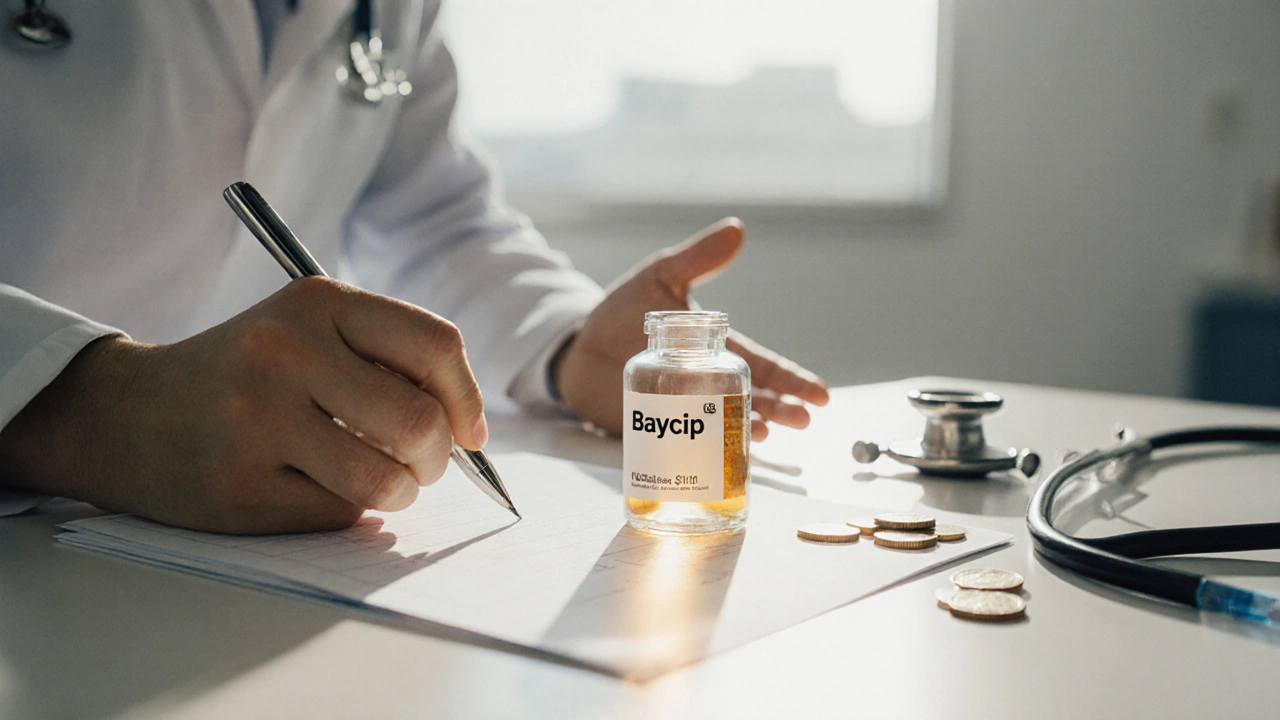
Baycip vs. Alternatives: Antibiotic Comparison Tool
Broad gram-negative coverage, high oral bioavailability
Once-daily dosing, good lung penetration
Well-tolerated, cheap, narrow spectrum reduces resistance pressure
Short course, excellent tissue penetration
Broad spectrum, excellent CNS penetration
Quick Takeaways
- Baycip delivers a high dose of Baycip (ciprofloxacin) for serious bacterial infections.
- Fluoroquinolones like Baycip are broad‑spectrum but carry risks of tendon damage and resistance.
- Levofloxacin offers similar coverage with a once‑daily dosing schedule.
- Amoxicillin works well for many common infections but lacks the gram‑negative punch of ciprofloxacin.
- Azithromycin is useful for atypical pathogens and has a shorter treatment course, yet it’s not a direct substitute for fluoroquinolones.
What is Baycip?
Baycip is a brand‑name formulation of ciprofloxacin, a synthetic fluoroquinolone antibiotic. It was introduced in the early 2000s and is marketed for acute bacterial infections that require a potent, oral, broad‑spectrum agent.
Baycip comes in 250mg and 500mg tablets, with the 500mg strength commonly prescribed for more severe infections such as complicated urinary tract infections, bacterial prostatitis, and certain abdominal infections.
How Ciprofloxacin Works
Ciprofloxacin interferes with bacterial DNA gyrase and topoisomerase IV, enzymes essential for DNA replication. By blocking these enzymes, the drug halts bacterial cell division, leading to bacterial death - a classic bactericidal mechanism.
Because DNA gyrase is prevalent in many gram‑negative organisms, ciprofloxacin excels against pathogens like Escherichia coli, Klebsiella pneumoniae, and Pseudomonas aeruginosa. However, its activity against gram‑positive cocci and anaerobes is limited, which is why clinicians often pair it with another agent when a mixed infection is suspected.
Common Alternatives to Baycip
When doctors consider alternatives, they weigh spectrum, dosing convenience, safety profile, and local resistance patterns. Below are the most frequently discussed substitutes.
- Levofloxacin - another fluoroquinolone with once‑daily dosing and slightly better activity against respiratory pathogens.
- Amoxicillin - a penicillin‑type antibiotic effective for many community‑acquired infections but weak against resistant gram‑negatives.
- Azithromycin - a macrolide that concentrates in tissues, making it useful for atypical pneumonia and certain sexually transmitted infections.
- Ceftriaxone - a third‑generation cephalosporin administered intravenously, chosen for severe infections where oral therapy isn’t enough.

Side‑Effect Profile and Safety Concerns
All fluoroquinolones, including Baycip, share a handful of class‑related warnings. The FDA label lists tendon rupture, peripheral neuropathy, and potential QT‑interval prolongation as serious, though rare, events. Gastrointestinal upset (nausea, diarrhea) is the most common mild side effect.
Levofloxacin carries a similar safety box, but its once‑daily schedule can improve adherence, reducing the chance of sub‑therapeutic exposure and resistance development. Amoxicillin’s primary concern is allergic reactions, especially in patients with penicillin hypersensitivity. Azithromycin may cause transient liver enzyme elevations and has a known interaction with drugs that prolong the QT interval.
Comparative Table: Baycip vs. Popular Alternatives
| Antibiotic | Class | Typical Use | Standard Adult Dose | Key Advantages | Main Drawbacks |
|---|---|---|---|---|---|
| Baycip (ciprofloxacin) | Fluoroquinolone | Complicated UTIs, prostatitis, abdominal infections | 500mg PO q12h | Broad gram‑negative coverage, high oral bioavailability | Risk of tendon rupture, resistance in some regions |
| Levofloxacin | Fluoroquinolone | Respiratory infections, skin infections, uncomplicated UTIs | 750mg PO q24h | Once‑daily dosing, good lung penetration | Similar class warnings, less activity against Pseudomonas |
| Amoxicillin | Penicillin | Sinusitis, otitis media, mild UTIs | 500mg PO q8h | Well‑tolerated, cheap, narrow spectrum reduces resistance pressure | Ineffective against many resistant gram‑negatives, allergy risk |
| Azithromycin | Macrolide | Atypical pneumonia, chlamydia, travel‑related diarrhea | 500mg PO day1, then 250mg daily days2‑5 | Short course, excellent tissue penetration | Limited gram‑negative activity, QT prolongation potential |
| Ceftriaxone | Third‑generation cephalosporin | Severe meningitis, gonorrhea, hospital‑acquired infections | 1-2g IV/IM q24h | Broad spectrum, excellent CNS penetration | IV only, biliary sludging with prolonged use |
How to Choose the Right Antibiotic
Deciding whether Baycip or an alternative is best depends on three practical factors:
- Pathogen profile. If cultures show a fluoroquinolone‑susceptible gram‑negative organism, Baycip remains a top choice. For typical respiratory pathogens, levofloxacin or azithromycin may be more convenient.
- Patient safety. Patients over 60, those on steroids, or individuals with a history of tendon problems should steer clear of fluoroquinolones. In those cases, amoxicillin or a cephalosporin becomes safer.
- Adherence considerations. Once‑daily regimens (levofloxacin) improve compliance compared with twice‑daily Baycip dosing, especially for out‑patient therapy.
Clinical guidelines (e.g., IDSA 2024) recommend reserving fluoroquinolones for situations where no equally effective, lower‑risk agents exist. That stewardship principle helps slow resistance and protects patients from avoidable adverse events.
Cost and Accessibility
In the United States, a typical 14‑day course of Baycip costs around $30-$45 without insurance, while generic ciprofloxacin tablets are often cheaper, hovering near $10. Levofloxacin’s generic version averages $12‑$20 for a similar duration. Amoxicillin, being one of the oldest antibiotics, can be as low as $5 for a two‑week supply. Azithromycin’s short‑course price sits near $15. These price points influence prescribing habits, especially in primary‑care settings where patients pay out‑of‑pocket.

When Baycip Is the Right Choice
- Complicated urinary tract infections caused by E. coli resistant to beta‑lactams. \n
- Bacterial prostatitis where high tissue penetration is critical.
- Severe intra‑abdominal infections where polymicrobial gram‑negative coverage is essential.
If the infection fits any of these scenarios, and the patient has no contraindications (e.g., recent tendon injury), Baycip often shortens hospital stay and avoids the need for IV therapy.
When an Alternative Is Safer or More Effective
- Community‑acquired pneumonia in a young adult - azithromycin or levofloxacin may offer better atypical coverage.
- Patients with a known fluoroquinolone allergy - amoxicillin or a cephalosporin should be selected.
- Pregnant or breastfeeding women - fluoroquinolones are generally avoided; amoxicillin is preferred.
Key Takeaways for Prescribers and Patients
Baycip delivers potent, broad‑spectrum action but carries class‑specific warnings that deserve careful patient selection. Levofloxacin offers similar potency with a simpler dosing schedule, while amoxicillin and azithromycin serve niche roles where gram‑negative coverage isn’t the priority. Always weigh pathogen susceptibility, safety profile, cost, and adherence before choosing the optimal agent.
Frequently Asked Questions
Can I take Baycip if I’m pregnant?
Ciprofloxacin is classified as pregnancy category C, meaning risk cannot be ruled out. Most guidelines advise using safer alternatives like amoxicillin unless the infection is life‑threatening and no other options exist.
How long should I stay on Baycip?
Typical courses range from 7 to 14 days, depending on infection severity and site. Always finish the full prescription even if symptoms improve early.
What are the signs of tendon damage while on fluoroquinolones?
Sudden pain, swelling, or a clicking sensation near the Achilles tendon, wrist, or shoulder should prompt immediate medical evaluation. Discontinue the drug if tendonitis or rupture is suspected.
Is resistance to ciprofloxacin a growing problem?
Yes. In many regions, especially where fluoroquinolones are overused, resistance rates in E. coli and Klebsiella have risen above 20%. Local antibiograms should guide prescribing.
Can I switch from Baycip to an IV antibiotic mid‑treatment?
Switching is possible, especially if the patient cannot tolerate oral meds or if a more aggressive IV regimen is needed. Common IV choices include ceftriaxone or piperacillin‑tazobactam, depending on culture data.
How does Baycip compare cost‑wise to levofloxacin?
Generic ciprofloxacin (the ingredient in Baycip) is usually cheaper than generic levofloxacin, but brand‑name Baycip can be pricier. Insurance coverage and pharmacy discounts often narrow the gap.





Comments (20)
Dustin Hardage
When assessing Baycip (ciprofloxacin) against its alternatives, it is essential to consider both pharmacokinetic properties and the epidemiology of resistance. The drug’s high oral bioavailability makes it a convenient option for serious gram‑negative infections, yet the class‑wide safety warnings necessitate judicious use. Clinicians should weigh the risk of tendon rupture against the benefit of avoiding intravenous therapy, particularly in outpatient settings. Moreover, local antibiograms often reveal rising resistance rates, which may diminish ciprofloxacin’s efficacy. In such cases, agents like levofloxacin or a third‑generation cephalosporin become more appropriate. Ultimately, the decision should be guided by pathogen susceptibility, patient comorbidities, and cost considerations.
Dawson Turcott
Wow, great, another "miracle" pill 🙄. Sure, just pop Baycip and hope you don’t end up with a snapped Achilles while you’re at it. Who needs simple antibiotics when you can have a side‑effect cocktail? 😂
Alex Jhonson
Hey folks, just wanted to add that while Baycip is powerful, it’s not a one‑size‑fits‑all solution. Different cultures may have varying access to alternatives, and it’s important we share knowledge equitably. If you’re in a setting where generic ciprofloxacin is affordable, it can be a real lifesaver. But where resistance is high, looking at local guidelines and perhaps using a cephalosporin might be wiser. Let’s keep the conversation inclusive and supportive for all patients worldwide.
Katheryn Cochrane
Seriously, the hype around Baycip is overblown. The risk profile alone should deter most prescribers from using it as a first‑line agent. Tendon rupture? Peripheral neuropathy? Those aren’t trivial side effects you can just brush off. And don’t even get me started on the escalating resistance; it’s a ticking time bomb. If you think a fluoroquinolone is a free pass, you’re living in denial. The data clearly show that overuse has rendered ciprofloxacin less effective in many regions. Clinical guidelines now caution against its indiscriminate use, yet we still see it being handed out like candy. It’s time to put patient safety above convenience.
Michael Coakley
Ah, the age‑old debate. Baycip shines bright until you stare at its warning label and realize it’s basically a legal disclaimer. Sure, it’s got impressive gram‑negative coverage, but so does levofloxacin without the need to remember q12h dosing. If you enjoy juggling pills, go ahead; otherwise, pick the easier route. In the grand scheme, the “once‑daily” badge on levofloxacin feels like a badge of honor compared to Baycip’s twice‑daily regimen. And let’s not forget the cost‑benefit analysis-why pay more for a brand when generic works just as well?
ADETUNJI ADEPOJU
From a pharmacological governance perspective, the indiscriminate deployment of ciprofloxacin contravenes the stewardship doctrine. The utilization of broad‑spectrum agents without stratified susceptibility data propagates selective pressure, fostering resistant phenotypes. It is incumbent upon clinicians to engage in evidence‑based decision‑making, leveraging local antibiograms as a compass. While the convenience of oral administration is laudable, it does not supersede the ethical imperative to preserve antimicrobial efficacy for future cohorts.
Janae Johnson
While the author extols the virtues of Baycip, one must question the underlying assumptions. The claim of “broad gram‑negative coverage” overlooks the nuanced spectrum gaps, notably against Pseudomonas spp. Furthermore, the assertion of “high oral bioavailability” is not unique to ciprofloxacin; levofloxacin offers comparable, if not superior, pharmacodynamics with a simpler dosing schedule. In academic rigor, these subtleties must be acknowledged rather than glossed over.
Kayla Charles
Let me take a moment to unpack the comparative landscape of Baycip versus its alternatives-not just in terms of raw pharmacology, but also the practical realities clinicians face on a day‑to‑day basis. First, when you examine the pharmacokinetic profile of ciprofloxacin, its high oral bioavailability certainly reduces the need for intravenous therapy, which can be a game‑changer for outpatient management. However, this advantage is mitigated by the fact that the drug’s half‑life necessitates a twice‑daily dosing schedule, which can be a compliance hurdle for many patients, especially those with complex medication regimens. In contrast, levofloxacin’s once‑daily dosing simplifies adherence, potentially improving outcomes in real‑world settings.
Moving on to the spectrum of activity, ciprofloxacin shines against many gram‑negative organisms, including many strains of E. coli and Klebsiella, but its efficacy wanes against certain resistant isolates and it offers limited gram‑positive coverage. Levofloxacin, while sharing many of these properties, typically provides better lung tissue penetration, making it a preferred choice for respiratory infections. Amoxicillin, on the other hand, offers an entirely different profile: it is inexpensive, well‑tolerated, and covers many common community‑acquired pathogens, but it falls short against resistant gram‑negatives that ciprofloxacin can handle.
Safety considerations cannot be ignored. The class‑wide warnings for fluoroquinolones-tendon rupture, peripheral neuropathy, QT prolongation-are not trivial. For patients over 60, those on corticosteroids, or individuals with a prior history of tendon issues, the risk may outweigh the benefits, steering clinicians toward alternatives like amoxicillin or a third‑generation cephalosporin, which have more favorable safety profiles. Cost is another practical factor; while generic ciprofloxacin can be affordable, brand‑name Baycip may be prohibitively expensive for some, especially without insurance coverage. This economic barrier often nudges prescribers toward cheaper, widely available options.
Finally, antimicrobial stewardship principles urge us to reserve broad‑spectrum agents for cases where no suitable narrow‑spectrum alternatives exist. The overuse of ciprofloxacin has contributed to rising resistance rates, a trend echoed in many local antibiograms. Therefore, before reaching for Baycip, it is prudent to obtain culture data when feasible, or at least to consider patient‑specific factors such as allergy history, comorbidities, and prior antibiotic exposure.
In summary, Baycip remains a potent tool in the antimicrobial arsenal, but its use should be judicious, balanced against the convenience of dosing, safety concerns, resistance patterns, and cost considerations. By taking a holistic view, clinicians can make more informed choices that benefit both individual patients and public health.
Paul Hill II
Baycip is pricey compared to generics.
Stephanie Colony
Only the enlightened truly appreciate the nuanced supremacy of Baycip’s pharmacodynamics, while the masses flail about with pedestrian, low‑tier antibiotics. It is an elitist’s choice, mind you, reserved for those who demand excellence over mediocrity.
Abigail Lynch
Everyone’s talking about resistance, but they ignore the fact that big pharma and the government are colluding to keep cheap antibiotics off the market. Baycip is just a pawn in their scheme, and the real cure is being hidden from us.
David McClone
Baycip’s broad coverage sounds great until you realize it’s a double‑edged sword, slicing both pathogens and patient safety. The risk-benefit ratio tilts unfavorably for many, especially when simpler agents suffice.
Jessica Romero
From a clinical pharmacology standpoint, it is imperative to juxtapose the pharmacodynamic parameters of ciprofloxacin with those of its contemporaries. The drug’s AUC/MIC ratio is favorable for gram‑negative organisms, yet the therapeutic window narrows considerably when patient‑specific variables such as renal impairment or concurrent QT‑prolonging agents are introduced. Hence, rigorous assessment of individual risk factors remains indispensable.
Michele Radford
The article’s rosy depiction of Baycip ignores the stark reality that its overuse fuels antimicrobial resistance, a public health calamity. Clinicians must adopt a more critical lens rather than praising a drug with such a worrisome safety profile.
Mangal DUTT Sharma
Hey everyone 😊, just wanted to share a quick thought: while Baycip can be a lifesaver in tough infections, remember to check for drug interactions, especially with antacids or supplements that can chelate fluoroquinolones. Also, stay hydrated! 💧 Proper hydration can reduce the risk of tendon issues that some patients worry about. If you’re pregnant or nursing, it’s best to discuss alternatives with your provider. Take care! 🌟
Gracee Taylor
Let’s keep the discussion civil and focused on evidence. Both Baycip and its alternatives have roles, and the best choice depends on the patient’s context and microbial data.
Leslie Woods
Do we really need another antibiotic guide? It's fine.
Manish Singh
Thanks for the info, really helpful. i think its important to consider patient preferrence and cost when choosing an antibiotic. be sure to check local resistance patterns.
Dipak Pawar
In the realm of antimicrobial therapeutics, a comprehensive evaluation of Baycip must transcend superficial efficacy metrics and incorporate a multidimensional analysis of pharmacokinetic, pharmacodynamic, and sociocultural determinants. The drug’s high oral bioavailability, while advantageous in reducing the need for intravenous access, simultaneously imposes a dosing frequency that may compromise adherence, particularly in resource‑limited settings where patient education is suboptimal. Moreover, the emergent data concerning fluoroquinolone‑associated adverse events-ranging from tendinopathy to perturbations in cardiac electrophysiology-necessitate a nuanced risk assessment stratified by age, comorbidities, and concomitant medications.
From a microbiological perspective, ciprofloxacin’s spectrum remains robust against many gram‑negative pathogens; however, its limited activity against enterococci and certain anaerobes underscores the need for combination therapy in polymicrobial infections. The increasing prevalence of quinolone‑resistant strains, as documented in regional antibiograms, further erodes the drug’s utility and compels prescribers to integrate susceptibility data into therapeutic decision‑making.
Economic considerations cannot be trivialized. While generic formulations mitigate cost barriers, brand‑name products like Baycip can impose financial strain, influencing patient compliance and, ultimately, clinical outcomes. Health systems must therefore balance drug acquisition costs against the broader economic impact of treatment failures and resistance propagation.
In alignment with antimicrobial stewardship principles, Baycip should be reserved for indications where its pharmacologic profile offers a distinct advantage, such as complicated urinary tract infections with documented susceptibility. For community‑acquired infections where narrow‑spectrum agents suffice, the preferential use of agents like amoxicillin or first‑generation cephalosporins aligns with both clinical efficacy and public health imperatives.
Finally, cultural competence and patient‑centred communication are essential. Engaging patients in shared decision‑making, elucidating the benefits and potential risks of Baycip versus alternatives, and respecting individual preferences will enhance therapeutic adherence and satisfaction.
In sum, the selection of Baycip must be predicated upon an integrative appraisal of scientific evidence, patient‑specific factors, and systemic considerations to ensure optimal therapeutic outcomes while mitigating the specter of resistance.
Jonathan Alvarenga
The piece glosses over the practical drawbacks of Baycip, delivering a one‑sided narrative that glorifies its utility without sufficiently addressing the profound safety concerns that have plagued fluoroquinolones for years. By failing to critically engage with real‑world data on tendon injuries, neuropathy, and cardiovascular risks, the article misleads readers into a false sense of security. Moreover, it downplays the economic ramifications of resistance, a factor that governmental health agencies have repeatedly flagged as a looming crisis. A more balanced exposition would juxtapose efficacy with toxicity, cost, and stewardship imperatives, rather than simply listing dosing regimens. Until such depth is provided, this guide remains an incomplete resource.